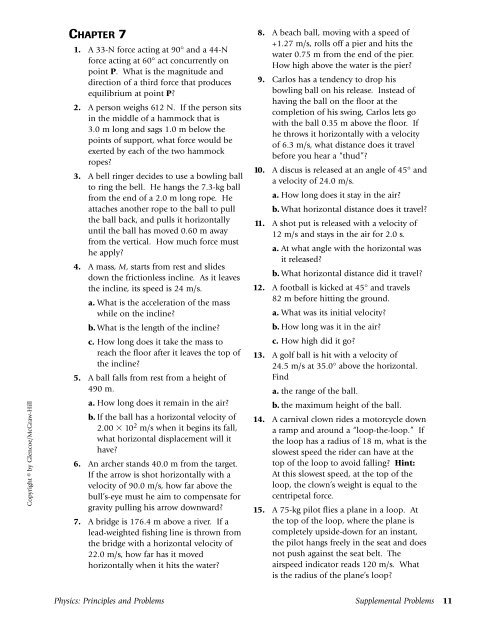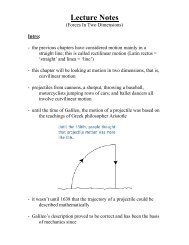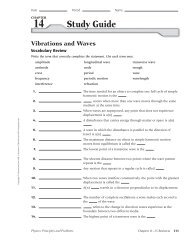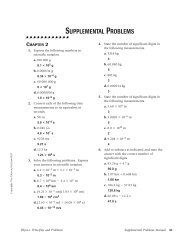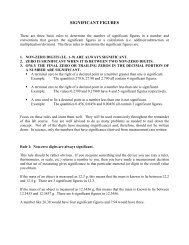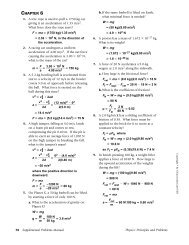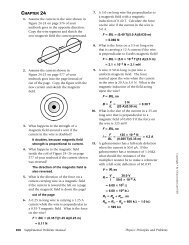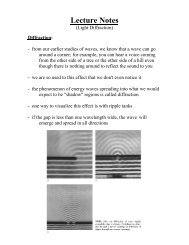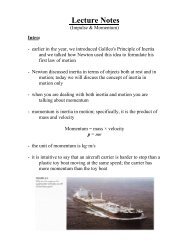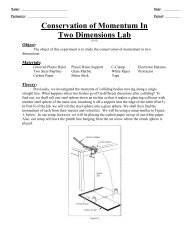Sup. Prob. 7.pdf - Dickey Physics
Sup. Prob. 7.pdf - Dickey Physics
Sup. Prob. 7.pdf - Dickey Physics
You also want an ePaper? Increase the reach of your titles
YUMPU automatically turns print PDFs into web optimized ePapers that Google loves.
Copyright © by Glencoe/McGraw-HillCHAPTER 71. A 33-N force acting at 90° and a 44-Nforce acting at 60° act concurrently onpoint P. What is the magnitude anddirection of a third force that producesequilibrium at point P?2. A person weighs 612 N. If the person sitsin the middle of a hammock that is3.0 m long and sags 1.0 m below thepoints of support, what force would beexerted by each of the two hammockropes?3. A bell ringer decides to use a bowling ballto ring the bell. He hangs the 7.3-kg ballfrom the end of a 2.0 m long rope. Heattaches another rope to the ball to pullthe ball back, and pulls it horizontallyuntil the ball has moved 0.60 m awayfrom the vertical. How much force musthe apply?4. A mass, M, starts from rest and slidesdown the frictionless incline. As it leavesthe incline, its speed is 24 m/s.a. What is the acceleration of the masswhile on the incline?b. What is the length of the incline?c. How long does it take the mass toreach the floor after it leaves the top ofthe incline?5. A ball falls from rest from a height of490 m.a. How long does it remain in the air?b. If the ball has a horizontal velocity of2.00 10 2 m/s when it begins its fall,what horizontal displacement will ithave?6. An archer stands 40.0 m from the target.If the arrow is shot horizontally with avelocity of 90.0 m/s, how far above thebull’s-eye must he aim to compensate forgravity pulling his arrow downward?7. A bridge is 176.4 m above a river. If alead-weighted fishing line is thrown fromthe bridge with a horizontal velocity of22.0 m/s, how far has it movedhorizontally when it hits the water?8. A beach ball, moving with a speed of+1.27 m/s, rolls off a pier and hits thewater 0.75 m from the end of the pier.How high above the water is the pier?9. Carlos has a tendency to drop hisbowling ball on his release. Instead ofhaving the ball on the floor at thecompletion of his swing, Carlos lets gowith the ball 0.35 m above the floor. Ifhe throws it horizontally with a velocityof 6.3 m/s, what distance does it travelbefore you hear a “thud”?10. A discus is released at an angle of 45° anda velocity of 24.0 m/s.a. How long does it stay in the air?b. What horizontal distance does it travel?11. A shot put is released with a velocity of12 m/s and stays in the air for 2.0 s.a. At what angle with the horizontal wasit released?b. What horizontal distance did it travel?12. A football is kicked at 45° and travels82 m before hitting the ground.a. What was its initial velocity?b. How long was it in the air?c. How high did it go?13. A golf ball is hit with a velocity of24.5 m/s at 35.0° above the horizontal.Finda. the range of the ball.b. the maximum height of the ball.14. A carnival clown rides a motorcycle downa ramp and around a “loop-the-loop.” Ifthe loop has a radius of 18 m, what is theslowest speed the rider can have at thetop of the loop to avoid falling? Hint:At this slowest speed, at the top of theloop, the clown’s weight is equal to thecentripetal force.15. A 75-kg pilot flies a plane in a loop. Atthe top of the loop, where the plane iscompletely upside-down for an instant,the pilot hangs freely in the seat and doesnot push against the seat belt. Theairspeed indicator reads 120 m/s. Whatis the radius of the plane’s loop?<strong>Physics</strong>: Principles and <strong>Prob</strong>lems <strong>Sup</strong>plemental <strong>Prob</strong>lems 11
Chapter 7 (continued)16.A 2.0-kg object is attached to a 1.5-m longstring and swung in a vertical circle at aconstant speed of 12 m/s.a. What is the tension in the string whenthe object is at the bottom of its path?b. What is the tension in the string whenthe object is at the top of its path?17. A 60.0-kg speed skater with a velocity of18.0 m/s comes into a curve of 20.0-mradius. How much friction must beexerted between the skates and ice tonegotiate the curve?18. A 20.0-kg child wishes to balance on aseesaw with a child of 32.0 kg. If thesmaller child sits 3.2 m from the pivot,where must the larger child sit?Copyright © by Glencoe/McGraw-Hill12 <strong>Sup</strong>plemental <strong>Prob</strong>lems <strong>Physics</strong>: Principles and <strong>Prob</strong>lems


